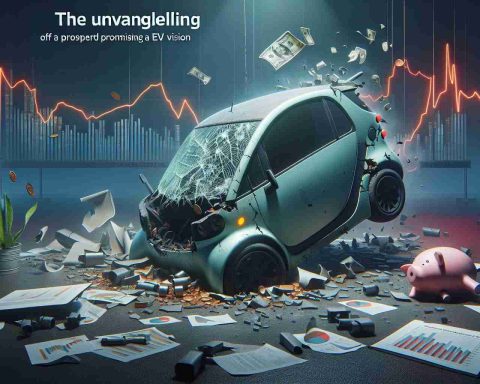Splinter’s Innovative Strategy in a Heated Debate
Electric fatbikes have emerged as a hot topic in the Netherlands, raising concerns over safety and legality. As the government considers regulatory changes, the manufacturer Splinter has taken proactive measures by introducing a buyback guarantee for its customers. This initiative reflects the sensitivity surrounding the issue.
The mushrooming problem with electric fatbikes stems from their potential to be easily modified, leading to risky riding experiences. With various actions taken, including law enforcement interventions and public inquiries, there is a growing call for clear regulations. New rules specific to electric fatbikes could materialize by the year’s end, spurring manufacturers to adapt.
To ease customer concerns, Splinter aims to assuage fears of future restrictions with its buyback option. This means that if customers feel the forthcoming laws are too stringent, they can return their bikes for a full refund process, allowing them peace of mind about their purchase.
Splinter emphasizes compliance with existing regulations, marketing its electric fatbikes strictly to adults. Additionally, the company supports local production and environmental initiatives by planting ten trees for every bicycle sold, showcasing its commitment to sustainability.
Although challenges exist, not all electric fatbikes fall under the scrutiny of modification issues, with certain brands adhering to regulations. As discussions continue, Splinter stands out by safeguarding its customers and promoting responsible biking solutions.
The Future of Electric Fatbikes: Splinter’s Innovative Approach to Safety and Sustainability
The Electric Fatbike Landscape in the Netherlands
In recent months, electric fatbikes have garnered significant attention in the Netherlands amid safety and legality concerns. As the government considers potential regulatory changes, manufacturers like Splinter are taking proactive stances to secure their market position and address customer worries.
Understanding the Risks and Regulatory Changes
Electric fatbikes are often modified for enhanced performance, leading to concerns about rider safety and compliance with existing laws. These modifications can inadvertently create hazardous situations on the roads. Consequently, there is increasing pressure on lawmakers to establish clear regulations governing the use and modification of these bikes. Stakeholders are anticipating that new rules will be introduced by the end of the year, raising expectations for manufacturers to adapt quickly.
Splinter’s Buyback Guarantee: A Safety Net for Customers
In response to the evolving regulatory environment, Splinter has introduced an innovative buyback guarantee. Customers who purchase an electric fatbike will have the option to return it for a full refund if they feel the upcoming regulations are too restrictive. This initiative not only provides reassurance but also emphasizes the brand’s commitment to customer satisfaction amid uncertainty.
Commitment to Compliance and Adult Safety
Splinter believes in prioritizing safety by marketing its electric fatbikes exclusively to adults and ensuring adherence to current safety regulations. This focus on compliance is a pivotal aspect of the company’s operational strategy, as they aim to establish themselves as leaders in responsible electric biking.
Sustainability Initiatives and Eco-friendliness
In today’s environmentally-conscious market, sustainability plays a crucial role in consumer decisions. Splinter is committed to minimizing its environmental footprint by implementing various sustainability initiatives. For every bike sold, the company plants ten trees, reinforcing its dedication to environmental stewardship. This approach not only enhances brand reputation but also aligns with a growing trend towards eco-friendly consumer choices.
Comparative Advantages of Splinter’s Electric Fatbikes
One of Splinter’s notable advantages is its ability to balance safety and performance without compromising on the user experience. While some competitors may overlook safety standards in favor of performance, Splinter ensures that its models meet rigorous compliance checks. This commitment is crucial for attracting safety-conscious consumers.
Limitations and Challenges Ahead
Despite its proactive measures, Splinter faces challenges similar to those affecting the entire industry. The complexity of potential regulations can create uncertainty and impact sales. Furthermore, the proliferation of unregulated models could overshadow those adhering to safety standards, complicating public perception.
Pricing and Market Position
Splinter’s electric fatbikes are competitively priced, aimed at the mid to high-end market segment. The company strategically positions itself to appeal to consumers who highly value eco-friendliness and safety in their biking choices.
Insights and Market Trends
The market for electric fatbikes is expected to grow significantly in the coming years, driven by increasing urbanization and a shift towards alternative transportation modes. Companies like Splinter, which emphasize compliance, sustainability, and customer care, are likely to thrive amid changing consumer preferences.
Conclusion: A Model for the Future
Splinter’s innovative approach to addressing safety and regulatory concerns, combined with its commitment to sustainability, sets a valuable precedent in the electric fatbike market. As the landscape continues to evolve, the company’s strategies might inspire other manufacturers to adopt similar practices, shaping the future of biking in a responsible and sustainable manner.
For more information about electric bikes and the future of sustainable transportation, visit Splinter Bikes.













